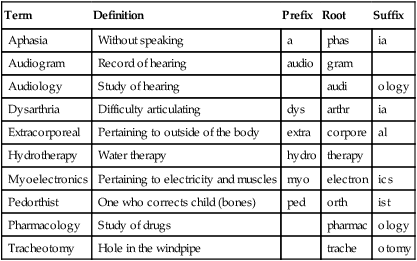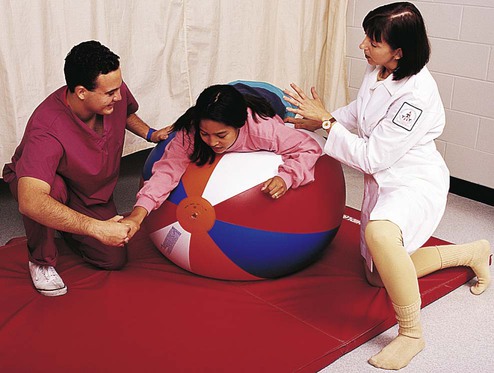Chapter 31 Rehabilitative Careers Terminology* *A transition syllable or vowel may be added to or deleted from the word parts to make the combining form. Rehabilitative careers provide a variety of working opportunities (Box 31-1). The rehabilitation team includes physicians, surgeons, physical therapists, occupational therapists, social workers, counselors, pharmacists, orthotists, and prosthetists who provide services designed to overcome physical, developmental, behavioral, or emotional disabilities (Table 31-1). The disabilities include impaired muscle strength, physical endurance, sensory or muscle coordination, concentration, and spatial discrimination. TABLE 31-1 Rehabilitative Career Educational Cost and Earnings *http://pt.unlv.edu/admission.html. Physical therapists (PTs) work to restore function, relieve pain, and prevent disability after disease, injury, or loss of a body part. PTs may specialize in many areas of practice, including rehabilitation, community health, sports, industry, research, education, and administration (Fig. 31-1). Additionally, PTs may work for a hospital or other health care facility or practice privately. Admission to the fewer than 30 college programs in physical therapy is competitive. Entry-level practice with a bachelor’s degree in physical therapy or a related area and completion of certification is being phased out. Master’s level preparation is preferred. PTs are licensed by the state. Corrective therapists conduct physical exercise programs to prevent muscle deterioration in inactive patients. The corrective therapist teaches the use of braces, crutches, and canes. Elastic stockings may be used for patients with limited mobility to decrease the chance of embolus development (Fig. 31-2). (See Skill List 31-1, Applying Elastic Stockings, p. 501.) Corrective therapists may complete bachelor’s or master’s degrees.
Rehabilitative Careers
 Define at least 10 terms relating to rehabilitative health care.
Define at least 10 terms relating to rehabilitative health care.
 Identify the function of the rehabilitative health care team.
Identify the function of the rehabilitative health care team.
 Describe the role of at least five of the rehabilitative health care team members, including personal qualities, levels of education, and credentialing requirements.
Describe the role of at least five of the rehabilitative health care team members, including personal qualities, levels of education, and credentialing requirements.
 Identify at least five methods or devices used to improve activities of daily living for the disabled.
Identify at least five methods or devices used to improve activities of daily living for the disabled.
 Describe two types of hearing loss and two methods of assessing defects in hearing.
Describe two types of hearing loss and two methods of assessing defects in hearing.
 Identify at least five common drug types and the expected action of each.
Identify at least five common drug types and the expected action of each.
 Identify the necessary components of a legal drug prescription, including the personnel qualified to write one.
Identify the necessary components of a legal drug prescription, including the personnel qualified to write one.
Term
Definition
Prefix
Root
Suffix
Aphasia
Without speaking
a
phas
ia
Audiogram
Record of hearing
audio
gram
Audiology
Study of hearing
audi
ology
Dysarthria
Difficulty articulating
dys
arthr
ia
Extracorporeal
Pertaining to outside of the body
extra
corpore
al
Hydrotherapy
Water therapy
hydro
therapy
Myoelectronics
Pertaining to electricity and muscles
myo
electron
ics
Pedorthist
One who corrects child (bones)
ped
orth
ist
Pharmacology
Study of drugs
pharmac
ology
Tracheotomy
Hole in the windpipe
trache
otomy

Careers
Career
Educational Cost*
Earnings†
Physical therapist
University of Nevada, doctor of physical therapy degree, 111 graduate credit hours
Fees include:
Tuition, books, & fees $30,626
Clinical rotation $17,726
Median annual salary: Las Vegas, Nev.—$90,050
Physical Therapist

Orthotist and Prosthetist
Rehabilitative Careers
Get Clinical Tree app for offline access













































